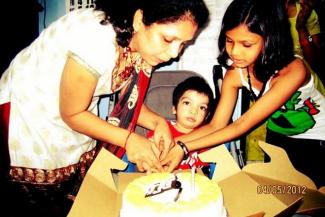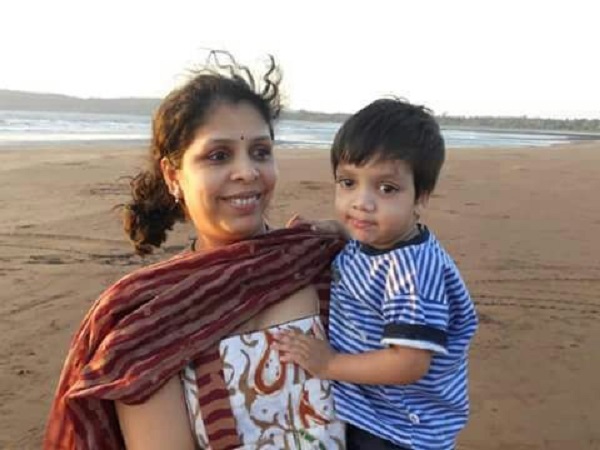
When a child is diagnosed with a rare disease, it is most agonising and traumatic for parents, especially because they are left alone and helpless. Shital Bhatkar, whose son Aarya succumbed to Niemann-Pick Disease, narrates her long, harrowing time trying to save her son and the need to include rare diseases in public health policies.
When my son, Aarya, was born, my husband and I considered ourselves blessed. We had two beautiful kids now – a daughter and a son and felt our family was complete. Both our kids were healthy and happy.
Aarya’s developmental milestones were falling in place as expected. It was only when he turned one-and-a-half year old, and was not able to walk, that an uneasy worry began to trouble me. I waited for some more time, and then finally took him to a paediatrician. The doctor checked him, but didn’t indicate anything. He recommended we visit a neurologist for further investigation. The best pediatric neurologists in Mumbai was Dr Vrajesh Udani at Hinduja Hospital. But there was a waiting time of nearly two months for his appointment. We decided to wait.
In those two months, we saw an improvement in Aarya and felt we were worrying unecesarily. He started holding things and walking. The only unusual feature about Aarya was that he had a slightly bigger tummy than other children of his age. But, you know, babies sometimes have big eyes, big stomachs. We dismissed it as a non-issue.
When we visited Dr Udani, he inspected Aarya closely. But when he saw Aarya’s swollen abdomen and found him to be anemic, his face took on a concerned expression. He said he suspected a disease called Storage Disorder. What’s Storage Disorder? We thought it was something to do with the digestive system. It was only when we returned home and read about Storage Disorder that we turned absolutely cold with fright.
What's A Storage Disorder?
Storage Disorders were categorised among the rare diseases in the world. There were just one or two drugs available in some Western countries for it. We were very confused and concerned but kept our hopes high. The doctor also was not able to give us a clear picture.
Three months later, Aarya had an attack of typhoid. This time Dr Udani recommended that we get a bone marrow test done to make certain that it was Storage Disorder. The tests were positive, unfortunately. It was then we learnt that there are over 50 different types of Storage Disorders. Which one did Aarya have? Only then could we start any treatment.
After agonizing for nearly a month, we found that there was no pathological lab in India which could do a detailed test for Storage Disorder. The only place we could send Aarya’s blood and tissue samples was all the way to Netherlands. And, the earliest we would get the results was after five months. There was a place in Hyderabad which conducted these tests also, but their results were not guaranteed.
Diagnosed with Niemann-Pick Disease Type C. Now Chase the Cure
Five months later we heard from Netherlands. Aarya was diagnosed with Niemann-Pick Disease Type C (NPD), a rare fat cell Storage Disorder. We rushed back to Dr Udani. The Doctor was helpful but couldn’t do much. Now we had got the diagnosis, but where were to run for cure. We had no clue where to go or who to turn to.
We did all that anybody recommended…homeopathy, flower therapy, allopathy. In fact, when we heard that a life-saving drug ‘Zavesca’ for Lysosomal Storage Diseases (LSD) was available in Switzerland, we wanted to procure it at the earliest. When we wanted to buy it, we were told we would have to purchase the entire pack of 90 tablets costing rupees five lakh. Doctors in India were not aware. My husband and I were desperate for the medicine. But there were other obstacles. We had to get a host of permissions, including excise, to obtain it. Finally, after much delay the medicine arrived. When I opened the packet, I realized I could not take out a tablet and give it to him. One time dosage was only point six (.6) milligram. I somehow managed to get a small weighing scale. When I gave the medicine to Aarya, it was so bitter that he raised a huge protest to swallow it.
I continued Zavesca for six months, but it did not stabilize Aarya. Zavesca actually delays the onset of symptoms, it does not cure the disease.
By the time Aarya turned four, he started having problems swallowing food. Help and advice came unexpectedly from Bangalore. There was a family there who had set up a website for Niemann-Pick disease. We learnt from them that their son had a similar problem and they had fixed a peg in their child’s tummy to facilitate swallowing. The peg (Percutaneous endoscopy gastrostomy) or feeding tube is inserted directly into the stomach through the abdomen and is particularly useful in times of difficult swallowing for a length of time. We were advised that we should not delay on fixing the peg, because food can get into the lungs and cause complications. It was then we realised why Aarya would be constantly hungry, even though he was being fed regularly. His food had already started entering the lungs, instead of the stomach.
Finding Our Own Path Through the Daily Battles
We had to find our own path, take our own decisions. We didn’t know who to approach to ease Aarya’s pain. Like for the peg, we learnt later that there was a silicone peg also available, which required less maintenance and had greater longevity. We had to frequently remove and clean Aarya’s tube which would pain and irritate him exceedingly. It was tormenting to see our baby suffer with no doctor to help us.

By the time he was five-and-a-half years, his muscles had become weak. He was lost most his strength in his hands and legs and was almost bedridden. I would take him for physiotherapy every day, but he would hate doing any exercises. His bowel movements had become difficult and I was forced to give him enema. He would also exert himself while breathing now, so he had to be given continuous oxygen.
Through all this trying times, we continued our search for any bit of information on Storage Disorder. When Aarya was around six, we learnt that there was a support group for LSD in Delhi. Through them we learnt that there nearly 700 patients diagnosed with LSD in India. We were quite surprised by the number.
Put your child in comfort zone
Aarya breathed his last just a before his seventh birthday in February, 2015. My biggest learning experience from being with Aarya for seven years was that you should not subject your child to trial-and-error methods. I felt we were just experimenting with Aarya. Put your child in comfort zone. Let him enjoy and be happy. Make life most beautiful for your child.
I Started 'With Aarya' in Memory
In 2011, I had a started an NGO called With Aarya to create awareness about health issues in general. I would visit KEM Hospital and counsel patients and families. I realized one of their big problems was sourcing good, wholesome food at reasonable rates. In 2016, after Aarya was no more with us we started the Don Ghaas (Two Morsels) scheme in his memory. Under the scheme, we donate 200 food packets twice daily from Monday-Saturday outside KEM hospital for rupees ten to needy patients and families. We also provide financial assistance for MRI, ICU, suction machines, nebulizers, oxygen cylinders, etc. And we counsel, support, help and guide anybody who needs our help.
It is extremely sad that in a big country like ours with so many people, you are left out cold and helpless forced to fend for yourself in case, god forbid, you are burdened with a rare disease. The government does not do anything, doctors are clueless, there is no research, no medicine, no support. We need to pay more heed to rare diseases as a public health challenge.
Lysosomal Storage Diseases (LSD) a group of over 50 genetically inherited disorders characterized by the accumulation of undigested or partially digested macromolecules, which ultimately results in cellular dysfunction and clinical abnormalities.
Symptoms include: Delay in intellectual and physical development; Seizures; Facial and other bone deformities; Joint stiffness and pain; Difficulty breathing; Problems with vision and hearing; Anemia, nosebleeds, and easy bleeding or bruising; Swollen abdomen due to enlarged spleen or liver.
Niemann-Pick Disease is one of a group of lysosomal storage diseases that affect metabolism and that are caused by genetic mutations. The three most commonly recognized forms are Niemann-Pick Types A and B (ASMD or Acid Sphingomyelinase Deficiency) and Niemann-Pick Disease Type C (NPC).






